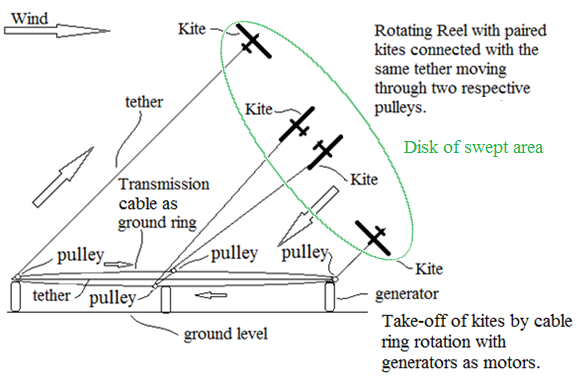This is also a step in the evolution of TRPT.
For @dougselsam patent: there is tensile rotary power transmission between the stacked rotors (Figures 83-91), and also in the basis (Figures 83, 84, 88, 89, 90, 91) but the rotors themselves are rigid.
For @Rodread : TRPT extends to the connection of the blades within a rotor (in spite of some thin rigid elements), in addition to the TRPT in the whole system (including rigid torque rings in the basis).
The Rotating Reel System (RRP) has no rigid part between both rotors, but the rotation is disturbed by the non-parallelism of the rotors. Later offshore and onshore versions with separate wings have been sketched:
hydro-carousel-figure-eight-rotating reel-Daisy.pdf (see figure 3), and the onshore version on:
 .
.
Perhaps the separate wings could partially solve the non-parallelism by a suitable control, in addition to have a higher L/D ratio. Indeed unlike for a rotor the whole wing goes fast. This configuration is rather close to that of a carousel, but with a direct drive of the ground rotor as for other TRPT and torque transfer rotary AWES. The only (but not insignificant) advantage I could see for RRP and all the variants was the flat horizontal installation of the ground rotor.
The Pyramid has also no rigid parts between the “flying rotor” and the ground rotor, and between the wings making up the rotor. And (as for other TRPT excepted Rotating Reel) both rotors are parallel. So the potential of power is fully maximized (parallelism + high glide ratio of the wings leading to a (advantageously) low Λ value + large swept area compared to the ground station).
A question to @tallakt : what would be the speed of the wing of style Makani 600 kW «October kite» (page 22), at 12 m/s wind speed, knowing the glide number including tether, at nominal CL, is 13.1?